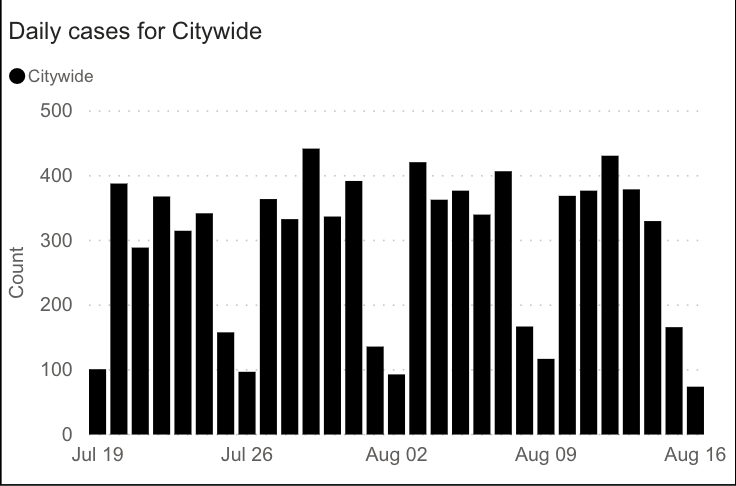For Chicago data nerds — and people anxious to see the city return to normal — checking the city’s COVID-19 dashboard and various other COVID-19 data websites can become a bit of an obsession.
But for those who’ve paid close attention, patterns have emerged in Chicago that have left them with questions.
Simon Doughty asked us on Facebook why the city’s weekly positivity rate is higher in one tab of the dashboard than another.
Jessica Fornari wrote to Curious City asking why coronavirus cases spike on Tuesdays and drop on weekends.
And we at Curious City wondered why daily case numbers continued to climb for several days after they were posted on the Chicago COVID-19 dashboard.
We take on each question below.
Dual positivity rates
To answer Simon’s question about why we see two different positivity rates (depending on the tab), we turned to the Chicago Department of Public Health. Officials there say they calculate positivity two ways: by dividing the number of tests taken over a period of time with the number of positive outcomes among those tests, and by dividing the number of people tested during a certain period of time with the number of positives. The latter method eliminates any repeat tests done on a single person during that period.
Heather Cherone at WTTW does an excellent job of breaking down the reasons for the inclusion of both rates here.
Why single-day cases continue to rise
Anyone who has checked the most recent COVID-19 case totals on the city’s dashboard could be forgiven for thinking Chicago was doing well. That’s because new case numbers for a single day can be as low as the single digits when they are first logged on the site.
But Health Commissioner Dr. Allison Arwady warns that these numbers can be deceptive because “data here will continue to be updated as we continue to get some lagging data in, usually for five to six days.”
So, as officials continue to backfill the data with new test results that come into the department from hospitals and other testing sites, those numbers will grow and create a more complete picture of how many positive tests came in for that day.
In fact, CDPH does not even include daily numbers in the seven-day rolling average, a key metric for city officials, until at least five days have passed.
Department spokeswoman Elena Ivanova wrote to WBEZ further explaining how that data lag plays into the city’s calculation of the rolling average:
“Current 7-day rolling average is calculated by starting 5 days ago as day x (because more recent data is incomplete) and taking the arithmetic average of the cases reported on that day x and on the six days previous to day x (total # of cases/7). This is calculated each day moving forward in time one day. Thus, referred to as rolling.”
And the figures can change even later than that. CPDH officials said some additional data for a certain day could arrive as late as two weeks later.
High Mondays and Tuesdays, and low weekend cases
For Jessica’s question about why cases are usually highest in the city on Tuesdays — but we at Curious City would also include Mondays — and lowest on the weekends, we also turned to CDPH.

Ivanova wrote back explaining the low weekend cases totals this way: “Since we report using specimen collection date, the low weekend numbers are indicative of lower testing numbers on those days compared to weekdays.”
So why is there less testing on the weekends?
Several testing sites, including many of the government-run sites, are closed on Saturdays and Sundays. And, because the city logs positive cases for the day the tests were taken — not on the day the positive test is confirmed — we see fewer positives on the weekend because there are fewer tests.
As for higher cases on Mondays and Tuesdays, CDPH would not answer questions about that particular trend. But a good guess might be that anybody who wanted to get tested over the weekend took the next open days: Monday and Tuesday.
More about our question asker
Simon Doughty is a longtime WBEZ member and a native of western England. With a doctorate in chemistry, he specializes in catalysts with an expertise in the reduction of pollution emissions. A self-proclaimed word and numbers nerd, Simon was quick to detect and ask about discrepancies — like two different positivity rates and an inaccurate phrase in a sentence — on the city’s COVID-19 dashboard.
When WBEZ pointed out the errant phrase that Simon noticed to a CDPH official, they acknowledged it was misleading and said they would change it.
Prior to the lockdown, Simon says he and his wife “enjoyed life in the city and the adventures of raising their blended family of four daughters, all products of Chicago Public Schools.”
Jessica Fornari was a math major in college and has watched the data from the city and state with a close eye.
“I have a math background, and I was not impressed with [the early methods officials used to report the cases] when I would get a red, yellow, green map,” she says. “So I started plotting the data daily on my own, and I noticed it would keep going up or down depending on the day. I noticed we would be doing really well on weekends, and then it would spike up again by Tuesday, and it would be demoralizing.”
Now that she knows the city is reporting positive test results on the day the test was taken (while the state reports on positive tests results the day the results are confirmed) and that more people take tests on Monday and Tuesday, the pattern makes more sense.
“I just hope we can keep on the right track so that we can get the heck out of this,” she says.
Jessica grew up in the Chicago suburbs and today lives downtown. For fun, she likes sports and socializing, “but I mostly have to be happy with texting and Zoom these days,” she says.
“I’m just glad I can still run on the lake,” she says. “But I’m just scared if these numbers change we will get that taken away again. Nobody wants to go back to that.”
Monica Eng is a WBEZ reporter. Contact her at meng@wbez.org.





